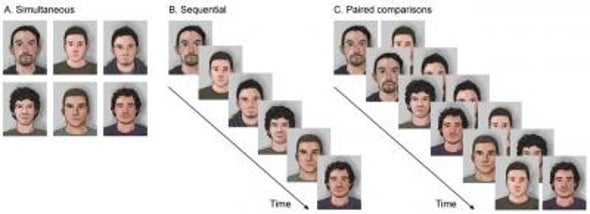(单词翻译:单击)
听力文本
This is Scientific American's 60-second Science, I'm Susanne Bard.
In 2006 a 26-year-old California man named Uriah Courtney was sentenced to life in prison for kidnapping and rape, despite having an alibi for the time the crimes were committed.
"And there were two witnesses. They saw a lineup in the police station, and they both identified the same person. And he was convicted, entirely based on those two eyewitness accounts."
Salk Institute for Biological Studies neuroscientist Tom Albright. He says years later, the California Innocence Project looked into the case.
"And it turns out that the DNA that was found at the crime scene was not the DNA of Uriah Courtney."
After eight years behind bars, Courtney was set free. But his case is not unique.
"There are now hundreds of cases in which individuals have been exonerated based on this post-conviction DNA analysis."
Most of these innocent people were sent to prison because witnesses misidentified them.
"Somebody picked them out of a lineup, and that information was taken seriously by the police. And the jury believed it."
Why do witnesses sometimes get it so wrong? Albright explains that our memory for visual events is notoriously flawed.
"If somebody tells us that they saw something, we figure, well, it must be true. They saw it with their own eyes."

Lineups typically show witnesses photos of six faces—five of innocent people and one of the suspect.
"The eyewitness is simply asked to identify any person that they remember from the crime scene."
But only having them pick their top choice doesn't account for how well the witness remembers that face. This issue can result in errors.
Albright's team thinks there's a better way—by tapping into the strength of the witness's memory. In an experiment, they had volunteers watch a clip of a grisly crime scene from an obscure Hollywood movie.
The next day, these study subject "witnesses" viewed a six-person lineup that showed just two faces at a time. Think of an eye test: Better now—or now?
"So on each pair, the witness will vote for one or the other of the faces: Which one looks more similar to the person you remember from the crime scene? We then tabulate that vote. And the face that has the largest number of votes is the winner."
Compared to traditional lineup techniques, the two-faces-at-a-time method led to a less biased and more accurate identification of the fictional perpetrator.
"People are far better at making relative judgments than they are at making absolute judgements."
The study is in the journal Nature Communications.
The researchers think their approach to lineups has the potential to reduce wrongful convictions, resulting in more justice for all.
Thanks for listening for Scientific American's 60-second Science. I'm Susanne Bard.
参考译文
这里是科学美国人——60秒科学系列,我是苏珊娜·巴德。
2006年,26岁加州男子乌利亚·考特尼因绑架和强奸被判处终身监禁,尽管他有不在犯罪现场的证明。
“有两名目击者。他们在警察局对一排人进行辨认,二人指认了同一个人。他被判有罪,完全基于这两个目击者的陈述。”
索尔克生物研究所的神经学家汤姆·奥尔布赖特说到。他表示,几年后,加州清白计划调查了此案。
“事实证明,在犯罪现场发现的DNA不是乌利亚·考特尼的DNA。”
在狱中度过八年后,考特尼被释放。但他的情况并非个例。
“目前有数百起个人因这一定罪后DNA分析而证明无罪的案件。”
这些无辜的人大部分被送进监狱,因为目击者误认了他们。
“有人将他们从一排人中挑出来,警方对这一信息非常重视。陪审团也相信了这个信息。”
为何目击者有时会错得如此离谱?奥尔布赖特解释说,我们对视觉事件的记忆存在显著的缺陷。
“如果有人告诉我们他们看到了什么,我们会想,那一定是真的。因为他们亲眼所见。”
通常在对一排人进行辨认时,目击者会看到6张脸的照片,其中5个是无辜者,1个是嫌疑人。
“目击者只被要求指认记忆中他们在犯罪现场看到的任何人。”
但仅让他们选出首选并不能说明目击者对那张脸的记忆有多清晰。这个问题可能导致错误。
奥尔布赖特的团队认为有更好的方法利用目击者的记忆力。在实验中,他们让志愿者观看好莱坞不出名电影中的恐怖犯罪现场的片段。
第二天,这些研究对象“目击者”查看了每次只展示两张脸的6人队列。想象一下进行视力测试的情况:现在这样更好,还是这样?
“因此,目击者会对这两张脸的其中一张投票:哪一张看起来更像你在犯罪现场记得的那个人?之后我们会将投票结果制成表格。得票最多的人就是嫌疑人。”
与传统的队列技术相比,这种一次展示两张脸的方法产生的偏颇更少,指认虚拟犯罪者的准确率也更高。
“人们做相对判断的能力远远强于做绝对判断。”
这项研究发表在《自然·通讯》期刊上。
研究人员认为,他们的列队方式有可能减少错误定罪,从而为所有人带来更多的公正。
谢谢大家收听科学美国人——60秒科学。我是苏珊娜·巴德。
译文为可可英语翻译,未经授权请勿转载!
重点讲解
重点讲解:
1. look into 考察;调查;研究;
The government has instituted a court of inquiry to look into the allegations.
政府已成立了调查法庭来调查这些指控。
2. pick out of 辨认出;分辨出;
Steven describes himself as 'a regular guy — you couldn't pick me out of a crowd'.
史蒂文形容自己是“一个普通人——放在人群中就找不出来的普通人”。
3. account for 解释;
Now, the gene they discovered today doesn't account for all those cases.
不过,他们现在发现的基因无法解释所有的病例。
4. result in 导致;引起;造成;
Food allergies can result in an enormous variety of different symptoms.
食物过敏会引发很多不同的症状。
关注微信公众号【可可双语精读】,获取详细讲解内容


